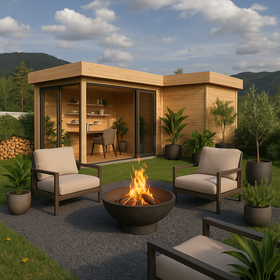512-777-0154

Who Invented the Term "Man Cave"?
Many people use the phrase without thinking about where it came from. But the question of who invented the term "man cave" has a fun little origin story.
It starts with a single newspaper line written in the early nineties and grows into a worldwide design trend. The path from a quirky quote to a global concept is full of personality.
Let’s walk through how this simple term found its place in homes everywhere.
The Man Cave Defined: Meaning and Spelling
Before diving into the history, it helps to understand what people actually mean when they use the phrase. The idea has grown and changed over the years, but the heart of it has stayed the same.
What is the True "Man Cave" Meaning?

A man cave is a personal retreat inside the home. It can be a basement, spare room, attic, garage, or any corner where someone can unwind. It holds hobbies, comfort items, and things that spark joy. Some people use it to watch sports. Others use it to build, play, fix, or simply recharge.
Man Cave vs. Mancave: The Correct Spelling Debate
Two spellings pop up all the time. Most writers and dictionaries stick with “man cave” as two separate words. You still see “mancave” online or in ads because it is shorter and catches the eye. Both get the point across, but “man cave” remains the standard.
Uncovering the True Origin: Who Invented the Term "Man Cave"?
The term did not appear out of thin air. Its first published use came from a surprising place, and its rise to fame involved more than one person.
The Real Inventor: Joanne Lovering and the 1992 Toronto Star Article
The earliest known print use of “man cave” came from Joanne Lovering, a writer for the Toronto Star, in 1992. Her article described a room that served as a quiet getaway for men. It was a small detail in a larger story, but it planted the seed.
That single phrase marked the moment the term entered public language.
The American Catalyst: How John Gray Popularized the Term in the United States

The term spread quickly in the United States thanks to John Gray, author of the bestselling book Men Are from Mars, Women Are from Venus, released the same year. Gray explored the idea that people need personal space to think and recharge. Readers connected with that idea. The concept matched everyday life, and the term gained traction across talk shows, magazines, and home design discussions.
Man Cave Psychology: The Need for Autonomy and Escape
Behind the fun name sits real psychology. Personal space plays an important role in emotional balance, relationships, and mental health.
1. The Scientific Benefit: Stress Reduction and Cortisol Levels
Studies show that having a calm place to reset can lower cortisol levels. Cortisol is a hormone linked to daily stress. A private man cave bungalow helps the brain shift out of “busy mode.” Even small breaks can ease tension and improve overall well-being.
2. A Fortress of Solitude: The Importance of Uncompromised Expression
A classic garden house man cave also gives someone a place to express who they are. It might be filled with music gear, sports memories, game consoles, models, tools, or collectibles.
There is no need to match the living room decor. That freedom offers a sense of ownership and identity that is hard to find in shared spaces.
3. Strengthening Relationships Through Separation
Personal space can actually strengthen relationships. A short break can cool arguments before they happen. A quiet room helps people recharge so they can return with more patience and energy. Healthy distance often leads to better connection.
Ultimate Man Cave Ideas, Themes, and Essential Elements
The fun part comes when planning the space. Themes and design choices can turn even a small corner into a great hideaway.
Top Man Cave Themes for Design Inspiration

Here are classic and creative themes people love:
- Sports Arena with jerseys and a game-day screen
- Retro Arcade with bold lights and nostalgic machines
- Gentleman’s Lounge with warm decor and a small bar
- Gamer’s Den with a sharp setup and great sound
- Workshop Zone for tools and hands-on projects
- Music Studio with instruments and acoustic panels
Essential Design Checklist: Tech, Seating, and Decor
A solid man cave usually includes:
- Tech like a TV, projector, or sound system
- Comfortable indoor seating, such as recliners or a sectional
- Decor like posters, shelves, artwork, and personal items
- Extras like a mini fridge, bar cart, dartboard, pool table, or game table
These simple elements help shape the mood of the room and make it a space people actually want to use.
Making the Most of Small or Unusual Spaces
A man cave does not require a huge area. Small rooms can feel just as special. Use vertical storage to keep the floor clear. Add good lighting to set the mood. Choose foldable or wall-mounted pieces to open up tight areas. Even a closet or hallway nook can become a great little retreat.
From a 1992 Newspaper Quote to a Universal Design Trend
The term “man cave” began with a brief line in a 1992 Toronto Star article and grew into a concept recognized across the world. The idea blends psychology, design, and personal identity. It continues to evolve as people find new ways to shape their own retreat.
A simple phrase has turned into a lasting part of home culture and a favorite spot for many to unwind.



